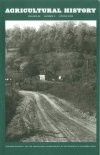RHN 94/2013 | Publication
Contents:
The Farm Debut of the Gasoline Engine
Carrie A. Meyer
pp. 287-313
Abstract: Advertisements for internal combustion engines, commonly called gas engines, appeared regularly in farm magazines in the mid-1890s. By the century's turn, one hundred US companies produced stationary or portable gas engines for farmers. Fifteen years later, the number of gas engines on farms had exploded to one million. The skills gained by hundreds of thousands of farmers with these engines facilitated the rapid adoption of the automobile on farms and the more gradual adoption of the tractor. Yet the use of such engines has received scant attention. This paper examines the farm demand for stationary power and compares alternative power sources in 1895. It traces the development of the market for farm gas engines and its interaction with the markets for automobiles and tractors. It then presents evidence from magazines to show how farmers became engine mechanics and facilitated the adoption of automobiles and tractors across rural America.
Reflections on One Hundred and Fifty Years of the United States Department of Agriculture
Sarah T. Phillips, Dale Potts, Adrienne Petty, Mark Schultz, Sam Stalcup, Anne Effland
pp. 314-367
Abstract: This group of essays recognizes the sesquicentennial of the United States Department of Agriculture. The USDA was created in 1862, part of a body of legislation that the Union was able to enact once free from the constraints of the southern states. The legislation—the Morrill Land Grant Act, establishing federally supported higher education; the Homestead Act, allowing citizens to claim federal land in the American West; and the Pacific Railway Act, allotting federal land to private companies to capitalize railroad construction—substantially extended the reach of the federal government. Arguably, of all the 1862 legislation, the creation of the USDA has had the greatest impact on the lives of American citizens and on people around the world. With a wide mandate ranging from food stamps to foreign diplomacy, from tourism to grain surpluses, the USDA has both mirrored and influenced the good and bad of American culture. These five idiosyncratic essays address some of the myriad aspects of the USDA, reflecting on its history, writ large; its management of the nation's forests; its race relations; its efforts to conserve America's privately held lands; and its sometimes contradictory global initiatives. Together they comprise a varied set of lenses on this hugely influential bureaucracy.
Client Failures and Supervised Credit in the Farm Security Administration
Charles Kenneth Roberts
pp. 368-390
Abstract: The Farm Security Administration (FSA) was the New Deal's most sustained and successful effort to address chronic rural poverty in the United States, particularly through its program of rural rehabilitation. But at the time and since the effectiveness of rural rehabilitation has been overshadowed by the political fight over the FSA's survival and the more ambitious (and controversial) resettlement program. Examined in terms of the practical goals of reducing rural poverty, rather than as a gauge for political and ideological trends, the FSA had decidedly modest results. Some of this can be attributed to the limitations and restrictions imposed by hostile political forces and a stingy Congress, but as this essay shows, much of the fault lay within the FSA, as it struggled to define goals and carry out anti-poverty programs for some of the poorest people in America.
Neighborhood Exchange and the Economic Culture of Rural California in the Late Nineteenth Century
R. Todd Welker
pp. 391-415
Abstract: The character of local exchange has long assumed an important place in the historiographical debate on the capitalist transformation of the American countryside. Whereas that character has been carefully examined in nearly every rural corner of the United States, it is poorly understood in the context of early agricultural California. Based on a systematic analysis of the diaries of one California farmer, this essay explores the everyday, local exchange practices of ordinary farmers, especially among neighbors. It finds farmers relying on one another extensively for a wide range of goods and services and maintaining dealings that assumed both commercial and non-commercial characteristics. It argues, moreover, that such findings reinforce criticisms of how scholars have traditionally defined early California's rural economy and that they challenge some of the dominant paradigms in rural American historiography that characterize the nineteenth-century economy either in essential terms or in terms of an uneasy coexistence of ambivalent systems.
View the full table of contents and abstracts here: aghist.metapress.com
Source: aghist.metapress.com
